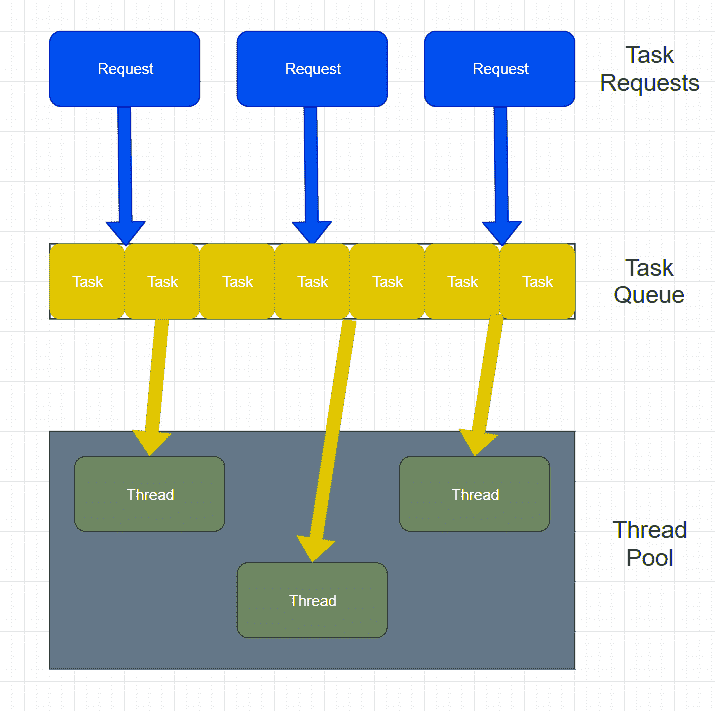# Java 线程池示例
> 原文: [https://javatutorial.net/java-thread-pool-example](https://javatutorial.net/java-thread-pool-example)
活动线程消耗系统资源,这可能导致 [JVM](https://javatutorial.net/jvm-explained) 创建太多线程,这意味着系统将很快用尽内存。

这就是 Java 中的线程池有助于解决的问题。
## 线程池如何工作?
线程池将先前创建的线程重用于当前任务。 这就解决了需要太多线程的问题,因此内存不足不是一个选择。 您甚至可以将线程池视为回收系统。 它不仅消除了用尽内存的选项,而且还使应用程序非常快速地响应,因为当请求到达时已经存在一个线程。

上图的工作流不仅可以控制应用程序正在创建的线程数,还可以控制计划任务的执行并将传入的任务保持在队列中。
## `Executor`,`Runnable`和`ExecutorService`
Java 提供了`Executor`框架,这意味着您只需要实现`Runnable`对象并将其发送给执行器即可执行。
要使用线程池,首先我们需要创建一个`ExecutorService`对象并将任务传递给它。`ThreadPoolExecutor`类设置核心和最大池大小。 然后,可运行对象将顺序执行。
## 不同的`Executor`线程池方法
```java
newFixedThreadPool(int size) - creates a fixed size thread pool
newCachedThreadPool() - creates a thread pool that creates new threads if needed but will also use previous threads if they are available
newSingleThreadExecutor() - creates a single thread
```
`ExecutorService`接口包含许多方法,这些方法用于控制任务的进度并管理服务的终止。 您可以使用`Future`实例控制任务的执行。 有关如何使用`Future`的示例:
```java
ExecutorService execService = Executors.newFixedThreadPool(6);
Future<String> future = execService.submit(() -> "Example");
String result = future.get();
```
`ThreadPoolExecutor`使您可以实现具有许多参数的可扩展线程池,这些参数包括`corePoolSize`,`maximumPoolSize`,`keepAliveTime`,`unit`,`workQueue`,`handler`,`threadFactor`。 但是,`corePoolSize`,`maximumPoolSize`和`keepAliveTime`是主要变量,因为它们在每个构造函数中都使用。
`corePoolSize`是要保留在池中的线程数,即使它们处于空闲状态,除非设置了`allowCoreThreadTimeOut`。
`maximumPoolSize`是池中允许的最大线程数。
`keepAliveTime`是当线程数大于内核数时,这是多余的空闲线程将在终止之前等待新任务的最长时间。
有关其他参数的更多信息,请访问[原始 Oracle 文档](https://docs.oracle.com/javase/7/docs/api/java/util/concurrent/ThreadPoolExecutor.html)。
## 线程池实现示例
工作流程步骤:
1. 创建要执行的任务
2. 使用执行程序创建执行程序池
3. 将任务传递给执行程序池
4. 关闭执行程序池
`Task.java`
```java
import java.text.SimpleDateFormat;
import java.util.Date;
import java.util.concurrent.ExecutorService;
import java.util.concurrent.Executors;
// (Step 1)
public class Task implements Runnable {
private String name;
public Task(String name) {
this.name = name;
}
public void run() {
try {
for (int i = 0; i < 5; i++) {
if (i == 1) {
Date date = new Date();
SimpleDateFormat ft = new SimpleDateFormat("hh:mm:ss");
System.out.println("Time initialization for task " + this.name + " is " + ft.format(date));
}
else {
Date date = new Date();
SimpleDateFormat ft = new SimpleDateFormat("hh:mm:ss");
System.out.println("Execution time for task " + this.name + " is " + ft.format(date));
}
Thread.sleep(1000);
}
}
catch(InterruptedException error) {
error.printStackTrace();
}
System.out.println(this.name + " completed");
}
}
```
`Main.java`
```java
import java.text.SimpleDateFormat;
import java.util.Date;
import java.util.concurrent.ExecutorService;
import java.util.concurrent.Executors;
public class Main {
public static void main(String[] args) {
Runnable task1 = new Task("task 1");
Runnable task2 = new Task("task 2");
Runnable task3 = new Task("task 3");
Runnable task4 = new Task("task 4");
Runnable task5 = new Task("task 5");
// (Step 2)
ExecutorService pool = Executors.newFixedThreadPool(3);
// (Step 3)
pool.execute(task1);
pool.execute(task2);
pool.execute(task3);
pool.execute(task4);
pool.execute(task5);
// (Step 4)
pool.shutdown();
}
}
```
**输出**:
```java
Time initialization for task task 2 is 10:18:40
Time initialization for task task 1 is 10:18:40
Time initialization for task task 3 is 10:18:40
Execution time for task task 3 is 10:18:41
Execution time for task task 1 is 10:18:41
Execution time for task task 2 is 10:18:41
Execution time for task task 2 is 10:18:42
Execution time for task task 3 is 10:18:42
Execution time for task task 1 is 10:18:42
Execution time for task task 1 is 10:18:43
Execution time for task task 3 is 10:18:43
Execution time for task task 2 is 10:18:43
Execution time for task task 3 is 10:18:44
Execution time for task task 1 is 10:18:44
Execution time for task task 2 is 10:18:44
task 2 completed
task 1 completed
task 3 completed
Time initialization for task task 4 is 10:18:45
Time initialization for task task 5 is 10:18:45
Execution time for task task 4 is 10:18:46
Execution time for task task 5 is 10:18:46
Execution time for task task 4 is 10:18:47
Execution time for task task 5 is 10:18:47
Execution time for task task 5 is 10:18:48
Execution time for task task 4 is 10:18:48
Execution time for task task 4 is 10:18:49
Execution time for task task 5 is 10:18:49
task 4 completed
task 5 completed
```
**上面的代码实现的细分**:
`Task.java`表示任务类。 每个任务都有一个名称实例变量,并且每个任务都使用构造函数实例化。 此类有 1 个方法,称为`run`。 在`run`方法的主体内,有一个`for`循环,该循环根据存在的任务数进行迭代。 在我们的例子中,有 5 个任务,这意味着它将运行 5 次。 第一次迭代,显示当前任务初始化的时间。 其他迭代,打印执行时间。 打印完成后,有一个`Thread.sleep()`方法调用,该方法用于以 1 秒的延迟显示每个迭代消息。 **注意**,像这样调用的方法名称`run`非常重要,因为它是来自`Task`类正在实现的`Runnable`的抽象方法。
仅在池中的某个胎面变得空闲时才执行任务 4 和 5。 在此之前,额外的任务将放置在队列中。
执行完所有任务后,请关闭线程池。
## 线程池何时有用
组织服务器应用程序时。 如本文开头所述,在组织服务器应用程序时非常有用,因为使用线程池非常有效,就像有许多任务一样,它会自动将它们放入队列中。 不仅如此,它还可以防止内存不足,或者至少可以显着减慢这样做的速度。 使用`ExecutorService`使其更易于实现。
- JavaTutorialNetwork 中文系列教程
- Java 基础
- Java 概述
- 在 Ubuntu 上安装 Java 8 JDK
- Java Eclipse 教程
- Eclipse 快捷方式
- 简单的 Java 示例
- Java 基本类型
- Java 循环
- Java 数组
- Java 读取文件示例
- Java 对象和类教程
- 什么是面向对象编程(OOP)
- Java 封装示例
- Java 接口示例
- Java 继承示例
- Java 抽象示例
- Java 多态示例
- Java 中的方法重载与方法覆盖
- Java 控制流语句
- Java 核心
- 如何在 Windows,Linux 和 Mac 上安装 Maven
- 如何使用 Maven 配置文件
- 如何将自定义库包含到 Maven 本地存储库中
- 如何使用 JUnit 进行单元测试
- 如何使用 Maven 运行 JUnit 测试
- 如何在 Java 中使用 Maven 创建子模块
- 如何使用 Maven 创建 Java JAR 文件
- 如何使用 Maven 创建 Java WAR 文件
- JVM 解释
- Java 内存模型解释示例
- 捕获 Java 堆转储的前 3 种方法
- Java 垃圾收集
- Java 互斥量示例
- Java 信号量示例
- Java 并行流示例
- Java 线程同步
- Java 线程池示例
- Java ThreadLocal示例
- Java 中的活锁和死锁
- Java Future示例
- Java equals()方法示例
- Java Lambda 表达式教程
- Java Optional示例
- Java 11 HTTP 客户端示例
- Java 类加载器介绍
- Java 枚举示例
- Java hashCode()方法示例
- 如何测试独立的 Java 应用程序
- SWING JFrame基础知识,如何创建JFrame
- Java SWING JFrame布局示例
- 在JFrame上显示文本和图形
- 与JFrame交互 – 按钮,监听器和文本区域
- 如何使用 Maven 创建 Java JAR 文件
- Java Collection新手指南
- 选择合适的 Java 集合
- Java ArrayList示例
- Java LinkedList示例
- Java HashSet示例
- Java TreeSet示例
- Java LinkedHashSet示例
- Java EnumSet示例
- Java ConcurrentHashSet示例
- Java HashMap示例
- Java LinkedHashMap示例
- Java TreeMap示例
- Java EnumMap示例
- Java WeakHashMap示例
- Java IdentityHashMap示例
- Java SortedMap示例
- Java ConcurrentMap示例
- Java Hashtable示例
- Java 中ArrayList和LinkedList之间的区别
- Java HashMap迭代示例
- Java HashMap内联初始化
- Java 中HashMap和TreeMap之间的区别
- Java 图示例
- Java 深度优先搜索示例
- Java 广度优先搜索示例
- 不同的算法时间复杂度
- Java 序列化示例
- Java 反射示例
- Java 中的弱引用
- Java 8 日期时间 API
- Java 基本正则表达式
- 使用 Java 检索可用磁盘空间
- Java 生成 MD5 哈希和
- Java 增加内存
- Java 属性文件示例
- 如何在 Eclipse 上安装 Java 9 Beta
- Java 9 JShell 示例
- Java 9 不可变列表示例
- Java 9 不可变集示例
- Java 9 不可变映射示例
- Java 单例设计模式示例
- Java 代理设计模式示例
- Java 观察者设计模式示例
- Java 工厂设计模式
- Java 构建器设计模式
- Java 比较器示例
- Java 发送电子邮件示例
- Java volatile示例
- Java Docker 和 Docker 容器简介
- 安装和配置 MySQL 数据库和服务器以供 Spring 使用
- 如何在 Java 中使用 MySQL 连接器
- 如何使用 Eclipse 调试 Java
- Java EE
- 如何在 Windows 10 中设置JAVA_HOME
- JavaBeans 及其组件简介
- 如何安装和配置 Tomcat 8
- 如何在 Tomcat 中部署和取消部署应用程序
- 从 Eclipse 运行 Tomcat
- Java Servlet 示例
- Java Servlet POST 示例
- Servlet 请求信息示例
- Servlet 注解示例
- 使用初始化参数配置 Java Web 应用程序
- Java Servlet 文件上传
- Java JSP 示例
- Glassfish 启用安全管理
- 如何使用 MySQL 配置 Glassfish 4
- Java 文件上传 REST 服务
- Glassfish 和 Jetty 的 Java WebSockets 教程
- 基于 Glassfish 表单的身份验证示例
- 如何使用 Java EE 和 Angular 构建单页应用程序
- Spring
- 在 Eclipse 中安装 Spring STS
- 使用 STS 创建简单的 Spring Web App
- Spring Web Framework 简介
- Java Docker 和 Docker 容器简介
- 在 Spring 中实现控制器
- Spring 中的PathVariable注解
- Spring 中的RequestBody注解
- Spring 中的RequestParam注解
- Spring 拦截器
- Spring IOC
- Java Spring IoC 容器示例
- Spring 中的DispatcherServlet
- Spring 示例中的依赖注入
- 实现 Spring MVC 控制器
- Spring ORM 简介
- 什么是 DAO 以及如何使用它
- 如何对 DAO 组件进行单元测试
- 如何对控制器和服务执行单元测试
- 安装和配置 MySQL 数据库和服务器以供 Spring 使用
- 如何在 Spring 中处理登录身份验证
- Spring Security 简介及其设置
- 如何使用 Spring 创建 RESTful Web 服务
- Spring CSRF 保护
- Spring 中基于 OAuth2 的身份验证和授权
- Spring Boot 简介
- Spring MVC 框架介绍
- Spring JDBC 简介
- 如何 docker 化 Spring 应用程序
- Spring 的@Autowired注解
- Spring AOP 中的核心概念和建议类型
- Sping Bean 简介
- 如何在 Java 中使用 MySQL 连接器
- 安卓
- 安装和配置 Android Studio
- 将 Android 设备连接到 Android Studio
- Android 简介,活动,意图,服务,布局
- 创建一个简单的 Android 应用
- 运行和调试 Android 应用程序
- 在虚拟设备上运行 Android 应用程序
- Android 活动示例
- Android 意图示例
- Android 服务示例
- Android 线性布局示例
- Android 相对布局示例
- Android Web 视图示例
- Android 列表视图示例
- Android 网格视图示例
- 带有ListAdapter的 Android ListView示例
- Android SQLite 数据库介绍
- Android SQLite 数据库示例
- Android 动画教程
- Android 中的通知
- Android 中的事件处理
- 如何在 Android 中发送带有附件的电子邮件
- 杂项
- 选择您的 JAVA IDE:Eclipse,NetBeans 和 IntelliJ IDEA
- Java S3 示例
- 如何在 Ubuntu 上为多个站点配置 Apache
- 如何在 Liferay DXP 中替代现成的(OOTB)模块
- 简单的 Git 教程
- 使用 Java 捕获网络数据包
- Selenium Java 教程
- 使用特定工作区运行 Eclipse
- 在 Eclipse 中安装 SVN
- 如何运行 NodeJS 服务器
- SQL 内连接示例
- SQL 左连接示例
- SQL 右连接示例
- SQL 外连接示例
- 树莓派
- Raspberry Pi 3 规格
- 将 Raspbian 安装到 SD 卡
- Raspberry Pi 首次启动
- 远程连接到 Raspberry Pi
- 建立 Raspberry Pi 远程桌面连接
- Raspberry Pi Java 教程
- 使用 PWM 的 Raspberry Pi LED 亮度调节
- Raspberry Pi 控制电机速度
- Raspberry Pi 用 Java 控制直流电机的速度和方向
